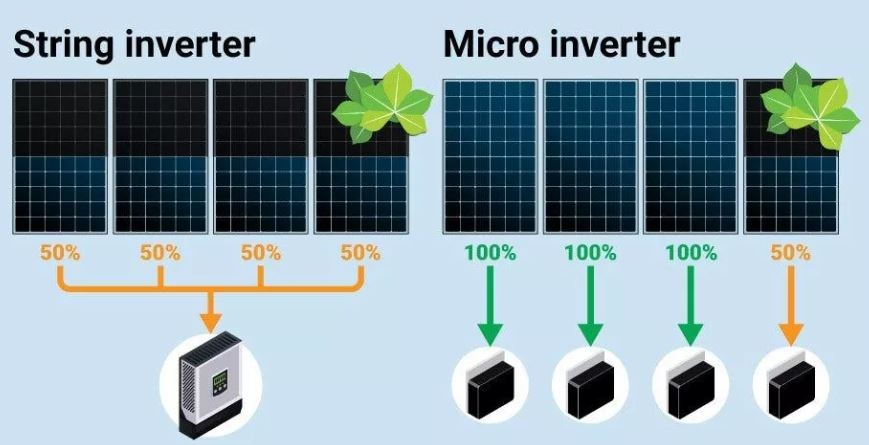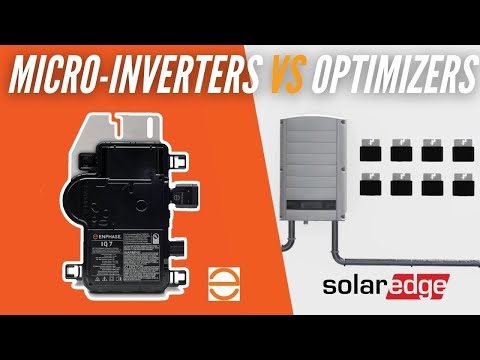Micro inverters convert DC to AC at each solar panel. Power optimizers condition the power before sending it to a central inverter.
Micro inverters and power optimizers are crucial in modern solar energy systems. Both technologies aim to maximize energy harvest and improve system efficiency. Micro inverters handle each panel individually, converting DC to AC on-site, which can enhance performance in shaded conditions.
Power optimizers, on the other hand, work with a central inverter, optimizing the DC output from each panel before conversion.
This system can be more cost-effective while still boosting efficiency. Understanding the differences helps in choosing the right technology for your solar power needs, ensuring optimal energy production and system longevity.

Credit: www.linkedin.com
Micro Inverters
Micro inverters are small devices. They convert DC to AC at each solar panel. This allows each panel to work independently. Performance issues in one panel do not affect others. They are usually installed on the back of solar panels.
Micro inverters increase the energy output of solar panels. They offer better monitoring of each panel. They are more reliable in shaded areas. They are easy to install and maintain.
Micro inverters are used in residential solar systems. They are also used in small commercial setups. They are ideal for installations with shading issues. They are a popular choice for homeowners.
Credit: plugpv.com
| You May Like: Portable Power Station vs Inverter
Power Optimizers
Power optimizers are small devices. They attach to each solar panel. These devices maximize the energy output. They work by adjusting the voltage. The adjustment happens in real-time. This ensures each panel works at its best.
Power optimizers can improve energy harvest. They reduce the impact of shading. They enhance monitoring of individual panels. They are also cost-effective. They are often less expensive than micro inverters.
Power optimizers are used in residential solar systems. They are also used in commercial solar installations. They are ideal for areas with partial shading. They are perfect for systems with varied panel orientations.
Technical Differences
Micro inverters convert the DC power from each solar panel directly into AC power. This happens at the panel level. Power optimizers work differently. They convert the DC power to a higher voltage DC. The DC is then sent to a central inverter for conversion to AC.
Installing micro inverters requires placing one inverter per solar panel. This makes the system more modular. Installing power optimizers also needs one optimizer per panel. But a central inverter is needed too. This can make the setup more complex.
Micro inverters are easy to replace since each panel works independently. This reduces downtime. Power optimizers need more maintenance. If the central inverter fails, the whole system can go down.
Performance Comparison
Micro inverters convert DC to AC at each panel. This boosts the overall energy yield. Power optimizers enhance each panel’s output but still rely on a central inverter. Both systems aim to maximize energy production.
Micro inverters offer high efficiency by working independently. Power optimizers improve efficiency at the panel level. Efficiency gains are not as high as with micro inverters. Both solutions aim to reduce energy loss.
Shading affects solar panels differently. Micro inverters can isolate shaded panels. This keeps the rest of the system efficient. Power optimizers minimize shading impact but still depend on a central inverter. Both systems improve overall system performance under shaded conditions.
| You May Like: Difference Between a Micro Inverter And A Power Optimizers
Cost Analysis
Micro inverters usually have a higher initial cost. Power optimizers tend to be less expensive upfront. The installation process for micro inverters can be more complex. This complexity can increase costs. Power optimizers are often simpler to install. This simplicity can lower initial expenses.
Micro inverters offer better performance over time. This can lead to higher energy savings. Power optimizers also provide energy savings but may not match micro inverters. Both systems improve solar panel efficiency. Regular maintenance is crucial for long-term benefits.
Micro inverters can provide a faster return on investment. Power optimizers may have a slower payback period. Both systems increase the value of your solar setup. Choosing the right system impacts overall savings. Consider both options for the best investment.
Suitability For Different Projects
Micro inverters are often used in small homes. They are easy to install and maintain. Power optimizers can also be used in homes. They work well with shaded roofs. Both options help to get more energy from each solar panel.
Commercial buildings need reliable solar solutions. Micro inverters offer good performance but can be pricey. Power optimizers are more cost-effective. They work well with many panels. Businesses often choose power optimizers for their projects.
Micro inverters are not ideal for large projects. They can be expensive and complex. Power optimizers are better suited. They help manage many panels easily. Large solar farms often use power optimizers. This makes the system more efficient.
Future Trends
Micro inverters and power optimizers are getting smarter. New models are becoming more efficient. They can handle more power. Software updates are making them better. These devices will soon have AI capabilities. This will improve energy management. It will also help in fault detection. Future designs will be smaller and lighter.
The market for micro inverters and power optimizers is growing. Solar energy is becoming more popular. More people are installing solar panels. This increases the demand for these devices. Prices are expected to drop. This will make them more affordable. New companies are entering the market. They are bringing innovative solutions. The competition will drive quality improvements.
Micro inverters and power optimizers help in reducing energy waste. They make solar panels more efficient. This leads to lower carbon emissions. Using these devices supports sustainable energy practices. They also have a long lifespan. This reduces the need for replacements. Recycling programs are being developed. This will help in proper disposal and recycling of old units.

Credit: www.youtube.com
Frequently Asked Questions
What Is A Micro Inverter?
A micro inverter converts DC power from a single solar panel into AC power. It is mounted directly on the panel. This system optimizes the output of each panel individually.
How Does A Power Optimizer Work?
A power optimizer works with a central inverter. It optimizes the performance of each solar panel. This system improves energy harvest and reduces losses.
Which Is More Efficient, Micro Inverter Or Power Optimizer?
Both systems have their merits. Micro inverters optimize at the panel level. Power optimizers work with a central inverter. Efficiency depends on the specific installation and conditions.
Are Micro Inverters More Expensive Than Power Optimizers?
Micro inverters are generally more expensive upfront. They offer better individual panel monitoring. Power optimizers can be more cost-effective in larger installations.
Conclusion
Choosing between micro inverters and power optimizers depends on your specific solar energy needs. Micro inverters offer individual panel monitoring, while power optimizers enhance overall efficiency. Both have their advantages, making them suitable for various installations. Understanding these differences helps you make the best decision for your solar power system.

